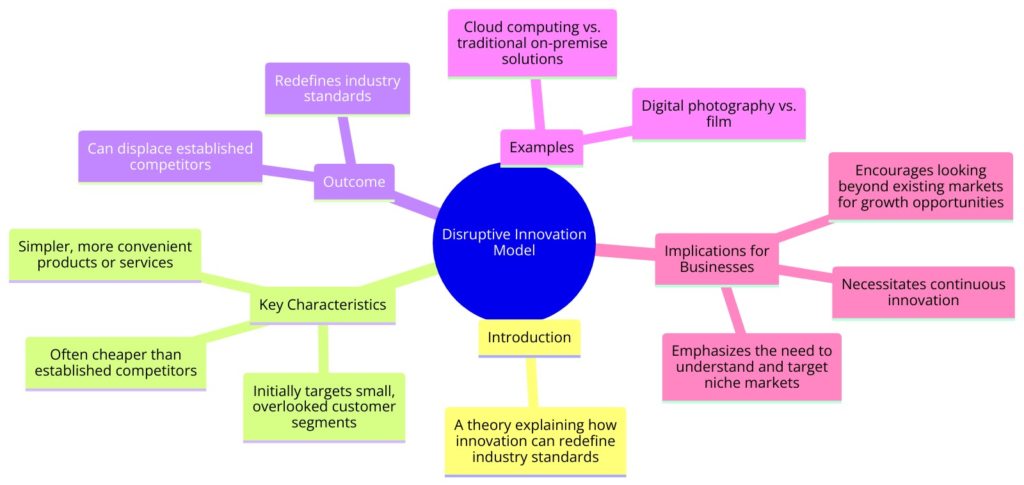Disruptive Innovation Model
The Disruptive Innovation Model is a theory that explains how simpler, more convenient, and often cheaper products or services initially targeting a small, overlooked customer segment can eventually redefine industry standards and displace established competitors. This model was introduced by Clayton M. Christensen in his 1997 book, “The Innovator’s Dilemma,” and has since become a foundational concept in the study of business strategy and innovation management.
What is the Disruptive Innovation Model?
Disruptive Innovation challenges the traditional view that businesses succeed by catering to the needs of their biggest and most demanding customers. Instead, it proposes that businesses can achieve tremendous growth by targeting those needs that are ignored by competitors, often because these needs are seen as too small or not profitable enough to pursue. Over time, these disruptive businesses improve their products or services to appeal to a broader audience, eventually overtaking incumbents in the market.
Origin of the Framework
Clayton M. Christensen, a professor at Harvard Business School, developed the Disruptive Innovation Model. Through his research, particularly on the disk drive industry, Christensen observed patterns where established companies would lose market dominance to newcomers that introduced innovations seemingly inferior to existing products but which gradually improved to meet the needs of the mainstream market.
How It Works
The model is characterized by several key principles:
- Disruptive innovations often start in niche markets or as a cheaper alternative to existing products. They do not appeal to the mainstream market initially because they underperform compared to what the market demands in terms of performance. However, they offer other benefits such as simplicity, convenience, or lower cost.
- Incumbents focus on sustaining innovations. Established companies concentrate on improving their products for their largest and most profitable customers, often overlooking the needs of smaller segments or entirely new markets.
- Performance trajectory. Over time, disruptive innovations improve in quality and begin to appeal to a larger portion of the market, eventually meeting the needs of mainstream customers.
- Market transformation. As the disruptive product gains traction, it redefines the expectations and demands of the market, leading to the displacement of established players who failed to adapt to the new market reality.
Why It Is Valuable
The Disruptive Innovation Model provides several valuable insights for businesses and entrepreneurs:
- It highlights the importance of understanding customer needs, especially those that are underserved or ignored by the market leaders.
- The model serves as a warning to established companies about the dangers of complacency and the need for continuous innovation, not just improvements to existing products.
- It offers a strategic framework for identifying and pursuing disruptive opportunities that could lead to significant growth and market transformation.
When and How to Use It
Businesses can apply the Disruptive Innovation Model in several ways:
- Identifying disruptive opportunities: Look for market segments that are underserved or for ways to make a product or service simpler, more accessible, or more affordable.
- Strategic positioning: New entrants can use disruption as a strategy to enter and eventually dominate a market, while incumbents can seek to identify potential disruptions early and either develop their disruptive innovations or acquire disruptive startups.
- Product development: Focus on creating products that may initially target a small market but have the potential to scale and appeal to a broader audience.
Shortcomings/Criticisms
The Disruptive Innovation Model has faced criticism and scrutiny over the years:
- Not all disruptive innovations succeed: Many supposed disruptive innovations fail to achieve the impact predicted by the model.
- Misapplication of the term: The term “disruptive innovation” is often overused or misapplied to any innovation that seems significant or novel, diluting its specific meaning.
- Predictability and hindsight bias: Identifying a truly disruptive innovation in advance is challenging, and many analyses are only clear in hindsight.
The Disruptive Innovation Model provides a powerful lens through which to understand how markets can be reshaped and how companies can achieve significant growth by targeting overlooked segments or by offering simpler, more accessible alternatives to established products. While not without its limitations, the model’s insights into the dynamics of market disruption remain a valuable tool for strategists and innovators alike.


